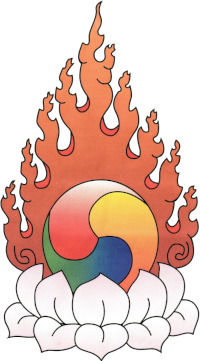Today’s talk is called “Nature of Mind.” This is a very tricky title. The moment you use “Nature of Mind” then not only you think about what mind is made of, but “nature” will give you some kind of sense of purity. Those who are familiar with Buddhist terminology may be thinking that the nature of mind is something other than mind itself. Traditional early Indian Buddhist teachings, before Buddhism even went to Tibet or China, or anywhere in SouthEast Asia, in that early period of Buddhism, one of those early text says, “Sem kyi rang zhin ö sel wa/ dri ma nam le lu bur wa.” Sorry, I don’t know the Sanskrit equivalent, but it means, “The nature of mind is luminous and all obstacles are temporary.”
If you are looking from that angle, then the moment you say, “nature of mind,” it becomes a little more sophisticated than simply looking at the nature of mind. When you use this title, “Nature of Mind,” to so many people it is just a catchy title, but to so many people it could bring up a lot of questions.
In the Buddhist teachings, what Buddha discovered, is that all phenomena are in the nature of emptiness. So is the mind. The nature of mind is also emptiness. This is interesting. Emptiness is something that so many people are curious about, and so many people are afraid of, and so many people think, “what is that,” and so many people like it. When you talk about the nature of emptiness, the pure nature and all of those probably refer to “Sem.” When you talk about the nature of empty, you very often notice that people say, “empty-ness.” People make a big distinction between empty and empty-ness. Empty is negative and empty-ness becomes positive. There is something, that’s why “ness” comes in. The moment you start thinking, you get all this. If you don’t think, you just don’t think. You can say empty or empty-ness and it is all the same, just because there is the word “empty.” If you look in that way, “empty” expresses that there is nothing there, but empty-ness expresses that there is something. They are all very complicated Buddhist subjects. On the other hand, it is also called, “Buddhist wisdom.” The wisdom is knowing that emptiness is all about. Let me put it this way: it is interesting how we look at ourselves. We use the words “me,” or “I” very often. Who is here? Me.Who said so? I said so. If you try to trace who is that me or I, who is speaking or doing things, we go very deeply within ourselves, somewhere inside, completely in that storage, the security controlled storage and find someone called, “me.” That’s what we normally perceive, something like that, something we cannot get it easily, nor can somebody else, yet, somehow we are in there, looking out.
It looks like a one way glass house. Deep inside, we are sitting there, looking out. Because of that somebody deep inside of me, “my” comes in. Because of “my,” you get “yours.” You begin to see a big division. Because of me and my, and you and yours, we begin to see closeness to me. me and my and aversion or distance to you and yours. There is a sense of belonging to me and my, or a sense of attachment to me and my. There is a dislike and hatred to you and yours. All of those are somehow building naturally within ourselves, each and every one of us. Even the little insects everywhere will have the same thing. Even the little ants have that me and my, you and yours.
~ Gelek Rimpoche, Jewel Heart Chicago, April 19, 2014


